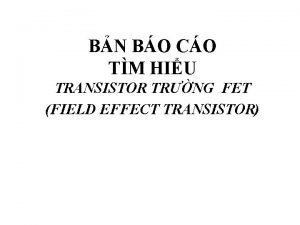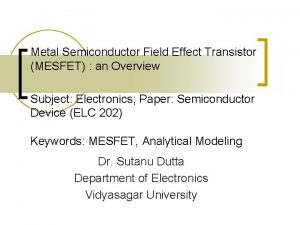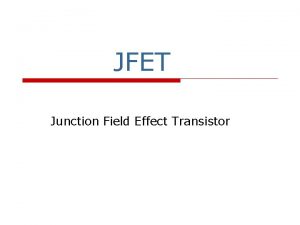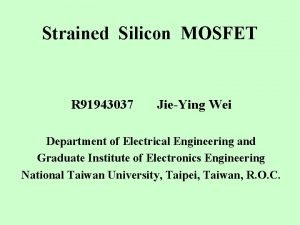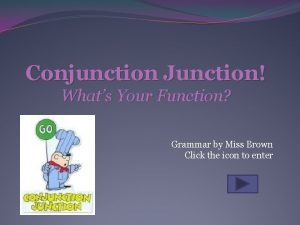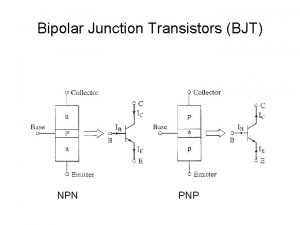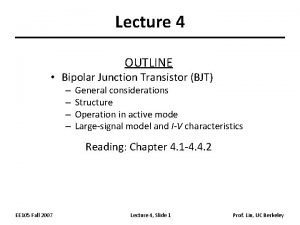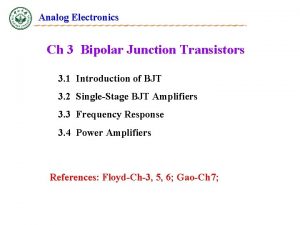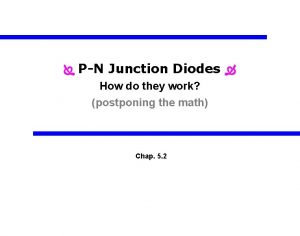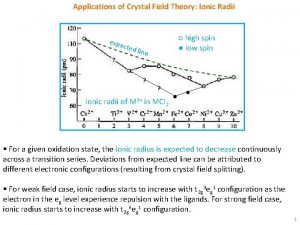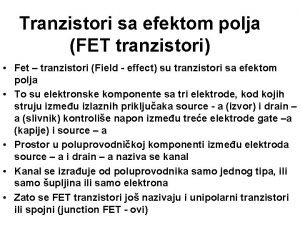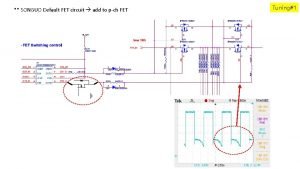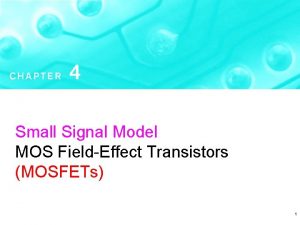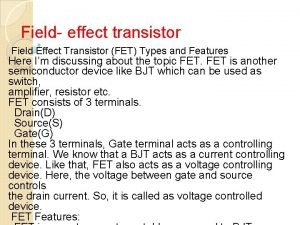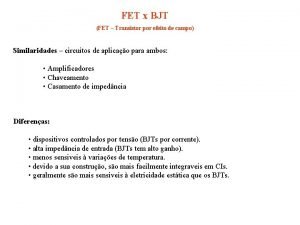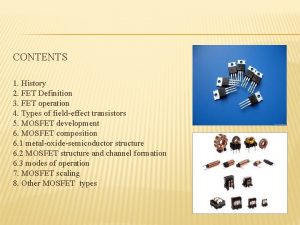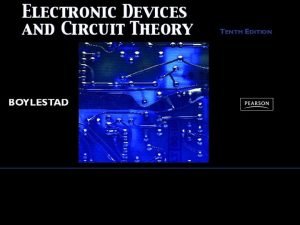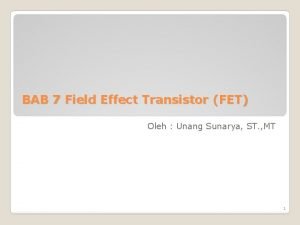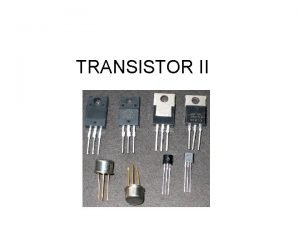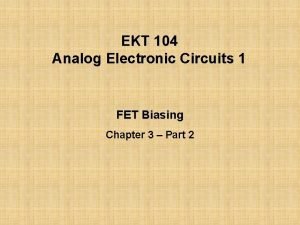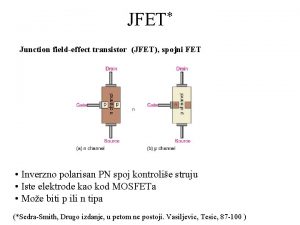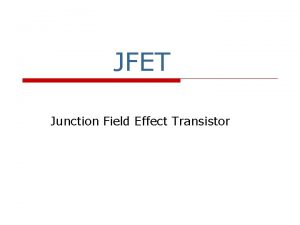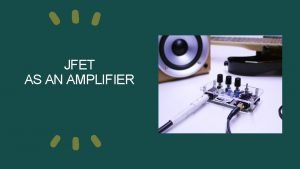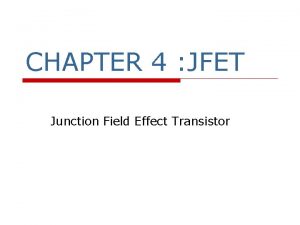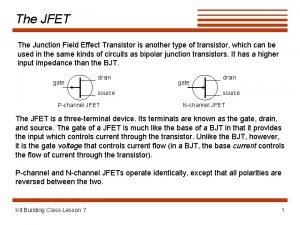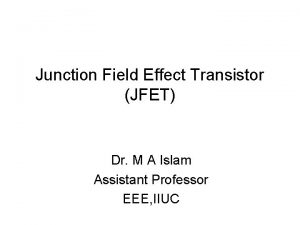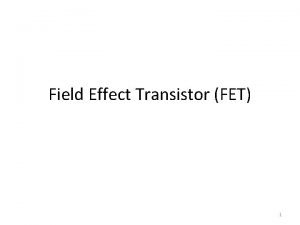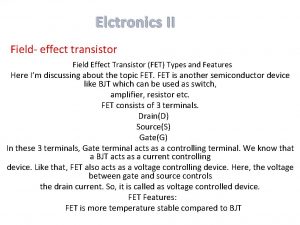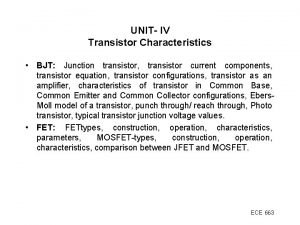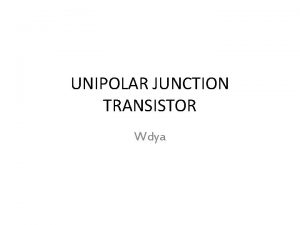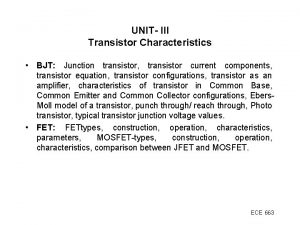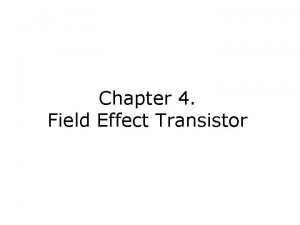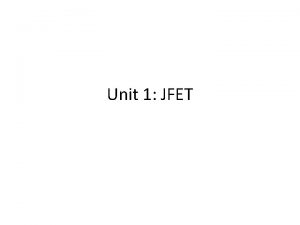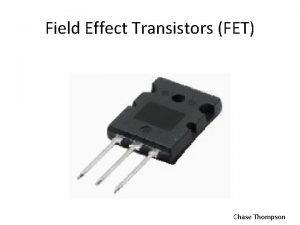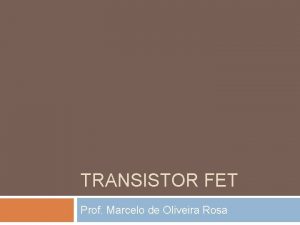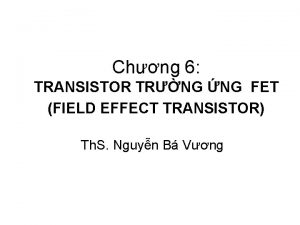JFET Junction Field Effect Transistor Introduction FET o





































- Slides: 37

JFET Junction Field Effect Transistor

Introduction (FET) o Field-effect transistor (FET) are important devices such as BJTs o Also used as amplifier and logic switches o What is the difference between JFET and BJT?

BJT is Current-controlled

FET is Voltage-controlled

Types of Field Effect Transistors (The Classification) § FET JFET n-Channel JFET p-Channel JFET MOSFET (IGFET) Enhancement MOSFET n-Channel EMOSFET p-Channel EMOSFET Depletion MOSFET n-Channel DMOSFET p-Channel DMOSFET

Introduction. . (Advantages of FET over BJT) o High input impedance (M ) (Linear AC amplifier system) o Temperature stable than BJT o Smaller than BJT o Can be fabricated with fewer processing o BJT is bipolar – conduction both hole and electron o FET is unipolar – uses only one type of current carrier o Less noise compare to BJT o Usually use as an Amplifier and logic switch

Disadvantages of FET o Easy to damage compare to BJT

Junction field-effect transistor. . o There are 2 types of JFET n n-channel JFET n p-channel JFET o Three Terminal n Drain – D n Gate -G n Source – S

SYMBOLS Drain Gate Source n-channel JFET Source p-channel JFET

N-channel JFET o N channel JFET: n Major structure is n-type material (channel) between embedded p-type material to form 2 pn junction. n In the normal operation of an n-channel device, the Drain (D) is positive with respect to the Source (S). Current flows into the Drain (D), through the channel, and out of the Source (S) n Because the resistance of the channel depends on the gate-to-source voltage (VGS), the drain current (ID) is controlled by that voltage

N-channel JFET. .

P-channel JFET o P channel JFET: n Major structure is p-type material (channel) between embedded n-type material to form 2 p-n junction. n Current flow : from Source (S) to Drain (D) n Holes injected to Source (S) through ptype channel and flowed to Drain (D)

P-channel JFET. .

Water analogy for the JFET control mechanism


JFET Characteristic for VGS = 0 V and 0<VDS<|Vp| o To start, suppose VGS=0 o Then, when VDS is increased, ID increases. Therefore, ID is proportional to VDS for small values of VDS o For larger value of VDS, as VDS increases, the depletion layer become wider, causing the resistance of channel increases. o After the pinch-off voltage (Vp) is reached, the ID becomes nearly constant (called as ID maximum, IDSS-Drain to Source current with Gate Shorted)

JFET for VGS = 0 V and 0<VDS<|Vp| Channel becomes narrower as VDS is increased

Pinch-off (VGS = 0 V, VDS = VP).

ID versus VDS for VGS = 0 V and 0<VDS<|Vp| JFET Characteristic Curve

JFET for (Application of a negative voltage to the gate of a JFET )

JFET Characteristic Curve. . o For negative values of VGS, the gate-to-channel junction is reverse biased even with VDS=0 o Thus, the initial channel resistance of channel is higher. o The resistance value is under the control of VGS o If VGS = pinch-off voltage(VP) The device is in cutoff (VGS=VGS(off) = VP) o The region where ID constant – The saturation/pinchoff region o The region where ID depends on VDS is called the linear/ohmic region


p-Channel JFET

p-Channel JFET characteristics with IDSS = 6 m. A and VP = +6 V.

Characteristics for n-channel JFET

Characteristics for p-channel JFET + + + P


Transfer Characteristics The input-output transfer characteristic of the JFET is not as straight forward as it is for the BJT. In BJT: I C= I B which is defined as the relationship between IB (input current) and IC (output current).

Transfer Characteristics. . In JFET, the relationship between VGS (input voltage) and ID (output current) is used to define the transfer characteristics. It is called as Shockley’s Equation: VP=VGS (OFF) The relationship is more complicated (and not linear) As a result, FET’s are often referred to a square law devices

Transfer Characteristics… o Defined by Shockley’s equation: o Relationship between ID and VGS. o Obtaining transfer characteristic curve axis point from Shockley: n When VGS = 0 V, ID = IDSS n When VGS = VGS(off) or Vp, ID = 0 m. A

Transfer Characteristics JFET Transfer Characteristic Curve JFET Characteristic Curve

Exercise 1 Sketch the transfer defined by IDSS = 12 m. A dan VGS(off) = - 6 VGS 0 0. 3 Vp 0. 5 Vp Vp ID IDSS/2 IDSS/4 0 m. A

Exercise 1 Sketch the transfer defined by IDSS = 12 m. A dan VGS(off) = Vp= - 6 IDSS VGS =0. 3 VP VGS =0. 5 VP IDSS/2 IDSS/4

Answer 1

Exercise 2 Sketch the transfer defined by IDSS = 4 m. A dan VGS(off) = 3 V VGS 0 0. 3 Vp 0. 5 Vp Vp ID IDSS/2 IDSS/4 0 m. A

Exercise 2 Sketch the transfer defined by IDSS = 4 m. A dan VGS(off) = 3 V IDSS/2 IDSS/4 VGS =0. 3 VP VP VGS =0. 5 VP

Answer 2
 Mosfet kênh cảm ứng
Mosfet kênh cảm ứng Metal semiconductor field effect transistor
Metal semiconductor field effect transistor Jfet curve
Jfet curve Specilis
Specilis Mosfetr
Mosfetr Junction junction what's your function
Junction junction what's your function Power bjt symbol
Power bjt symbol Large signal model of diode
Large signal model of diode Bjt construction
Bjt construction Bipolar junction transistor
Bipolar junction transistor Bjt transistor notes
Bjt transistor notes Bipolar junction transistor animation
Bipolar junction transistor animation Electric field pn junction
Electric field pn junction Bjt cbe
Bjt cbe Gauss law in magnetism
Gauss law in magnetism Field dependent vs field independent
Field dependent vs field independent Field dependent vs field independent
Field dependent vs field independent Distinguish between magnetic and nonmagnetic materials
Distinguish between magnetic and nonmagnetic materials Waveguide cutoff frequency
Waveguide cutoff frequency Data types and field properties
Data types and field properties Field dependent and field independent
Field dependent and field independent Difference between electric field and magnetic field
Difference between electric field and magnetic field Application of crystal field theory
Application of crystal field theory Jfet
Jfet Fet pch
Fet pch 1/gm mosfet
1/gm mosfet Mosfet i-v curve
Mosfet i-v curve The constant current area of a fet lies between
The constant current area of a fet lies between Fet
Fet Efeito transistor
Efeito transistor Simbol mosfet
Simbol mosfet Direct fet
Direct fet Definition of fet
Definition of fet Bjt and fet frequency response
Bjt and fet frequency response History fet caps
History fet caps Fet kanal p
Fet kanal p Bjt fet
Bjt fet Q point of mosfet
Q point of mosfet
